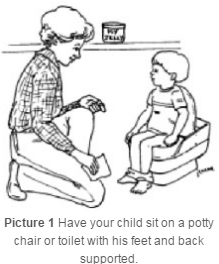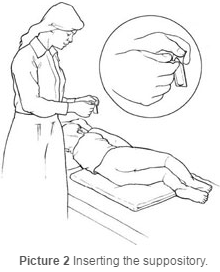Neurogenic Bowel Regulation
![]()
A child who has a neurogenic bowel cannot control when he or she has a bowel movement. The muscles in the anus cannot hold back stool between bowel movements. The nerves that tell your child he needs to have a bowel movement do not work right, either. For these reasons, you need to set a regular time each day for your child to have a bowel movement. Bowel control may not be possible, but with patience, bowel regulation can be done by following a daily schedule.
The success of bowel regulation also depends on how soft or hard the stool is. The stool should be formed and moist. The goal is for your child to have a bowel movement at the same time each day. This will help prevent accidents, constipation and diarrhea. Diarrhea may be a sign of constipation high up in the colon.
Bowel Regulation Schedule

Rectal Suppository Method

- Before you start, explain to your child what you are going to do and why. Show him the picture of a child sitting on a potty chair. (Picture 1).
- Have your child lie on his left side on a padded surface (Picture 2).
- Hold the suppository in your hand for about a minute. The warmth of your hand will make the suppository slippery. Remove the wrapper.
- Using a gloved finger, finger cot or a plastic sandwich bag, push the suppository at least 2 inches into the rectum, or as far as it will go. It is important to press the suppository against the inside wall of the rectum so it can be absorbed by the intestines.
- After the suppository is put in, have your child lie on his back or side for 20 minutes to let the suppository melt. While you are waiting you may read to him or do other quiet play activities. Gently press the buttocks together to keep the rectal opening closed.
- After 20 minutes have him sit on a potty chair or toilet to have a bowel movement.(Make sure his feet and back are supported). Do not force your child to sit more than 10 minutes. He may become frustrated and angry.
- Store suppositories in the refrigerator and out of reach of children.
Rectal Stimulation Method
- Explain to your child what you are going to do and why.
- Have your child sit sideways on a potty chair or toilet.
- Put a finger cot on your index finger and lubricate it with K-Y Jelly®. Use your little finger for an infant. Cut your fingernail short so the child's rectum is not injured.
- Gently insert your lubricated, gloved finger ½ to 1½ inches into the child's rectum. Firmly press against the sides of the rectum in a circular motion for no more than 1 to 3 minutes.
- Then have your child sit comfortably on the toilet seat with his feet and back supported to have his bowel movement (Picture 1). He should not sit longer than 10 minutes.
- If necessary, repeat the rectal stimulation in 15 minutes. Give him a hug for encouragement.
Enema Method
Important Things To Remember
- Antibiotic medicines can cause loose stools.
- Anticholinergic (an tie cho lin ER gick) medicines such as Ditropan® may harden stools.
- After an intestinal "upset," the bowel regulation schedule will need to be re-started.
- If the stools are too hard or too soft, follow the diet instructions given to you.(Also refer to the Helping Hand HH-I-97, Neurogenic Bowel: Abdominal Massage).
- Iron supplements may make the stool dark, black or "pasty." The child may get constipated.
